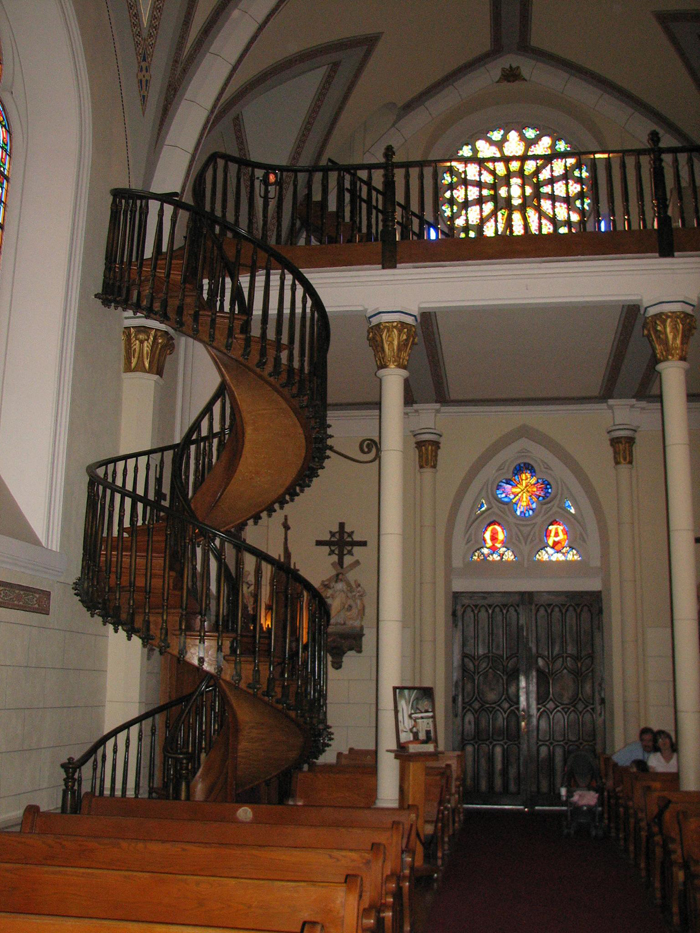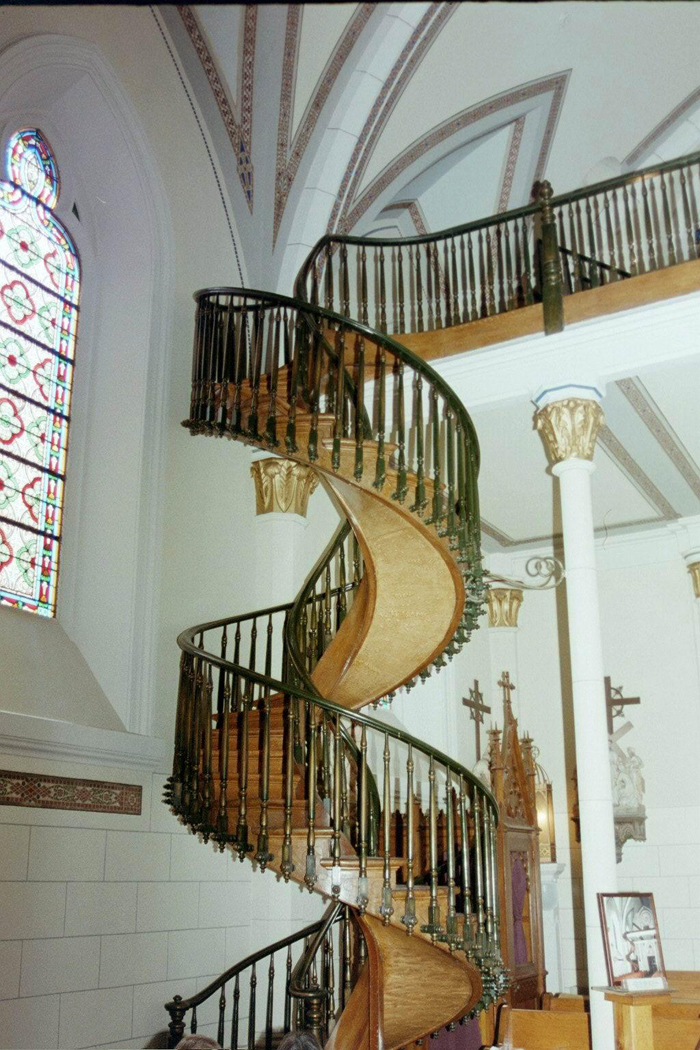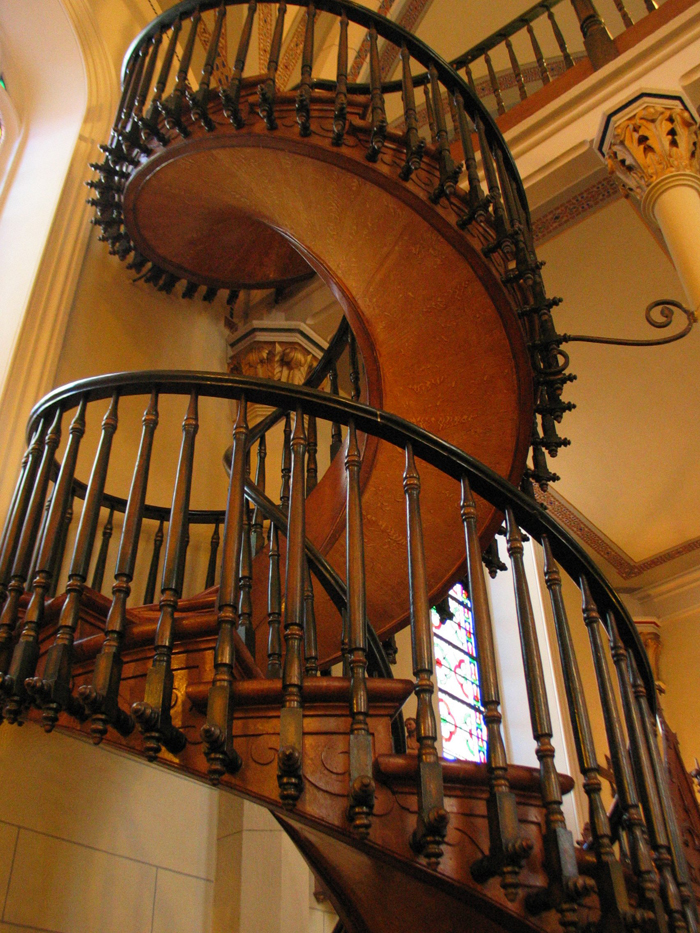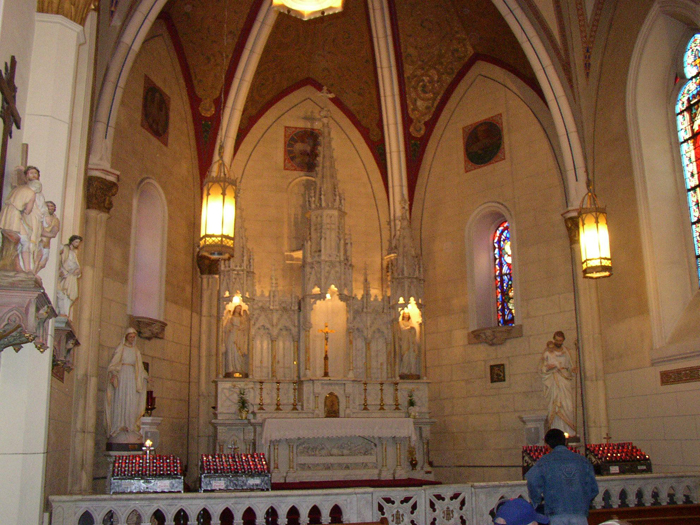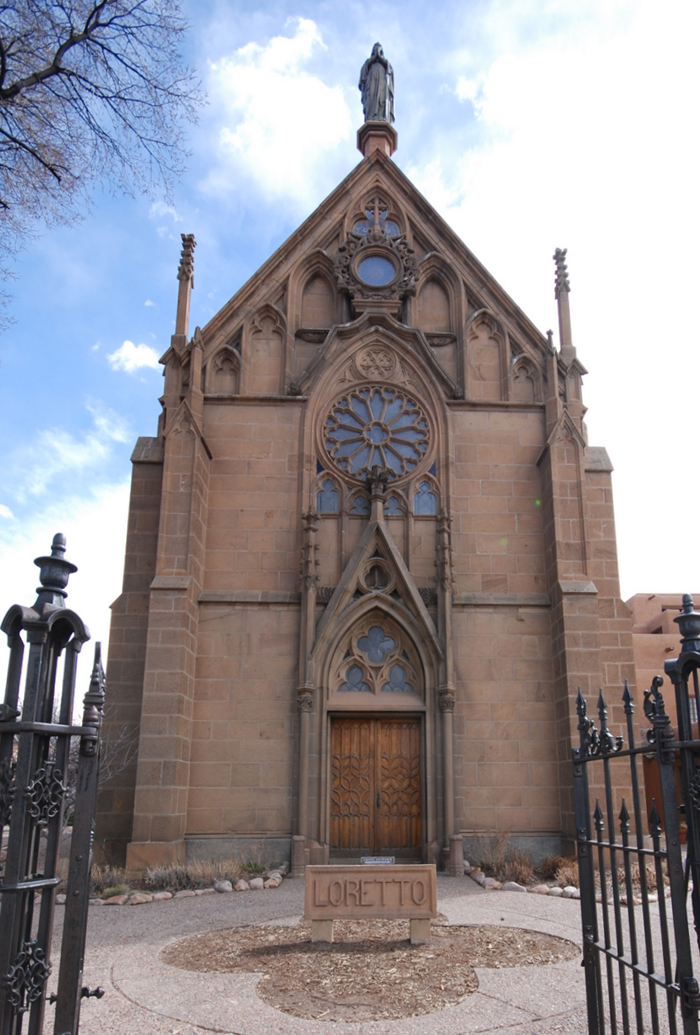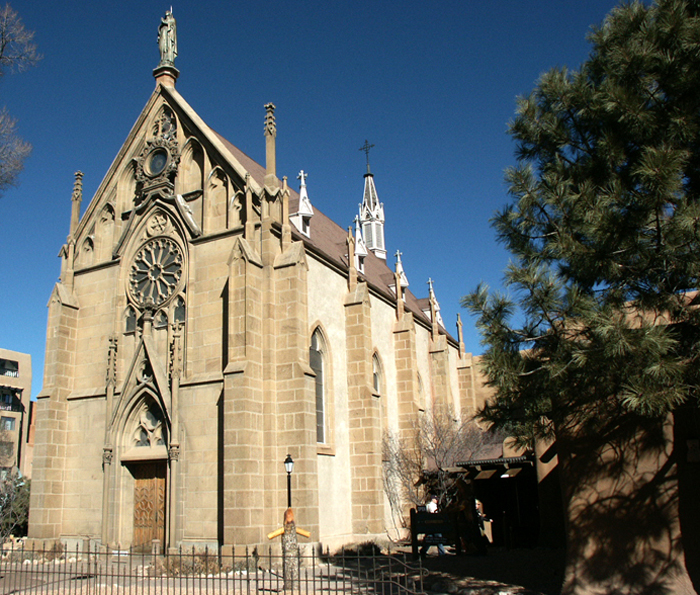
The Loretto Chapel is a chapel in Santa Fe, New Mexico known for its unusual spiral staircase that is an exceptional work of carpentry. The construction and builder of the staircase is considered a miracle by the Sisters of Loretto and many who visit it.
In 1872 Jean-Baptiste Lamy, the Bishop of the Santa Fe Archdiocese, commissioned the building of a convent chapel to be named Our Lady of Light Chapel, which would be in the care of the Sisters of Loretto. The chapel was designed by French architect Antoine Mouly in the Gothic Revival style, complete with spires, buttresses, and stained glass windows imported from France. Although it was built on a much smaller scale, the chapel bears an obvious resemblance to the Sainte-Chapelle in Paris.
The architect died suddenly and it was only after much of the chapel was constructed that the builders realized it was lacking any type of stairway to the choir loft. Due to the chapel’s small size, a standard staircase would have been too large. Historians have also noted that earlier churches of the period had ladders rather than stairs to the choir loft, but the Sisters obviously did not feel comfortable with that prospect because of the long robes that they wore.
The story of the miracle continues as follows.
Needing a way to get up to the choir loft the nuns prayed for St. Joseph’s intercession for nine straight days. On the day after their novena ended a shabby looking stranger appeared at their door. He told the nuns he would build them a staircase but that he needed total privacy and locked himself in the chapel for three months. He used a small number of primitive tools including a square, a saw and some warm water and constructed a spiral staircase entirely of non-native wood. The identity of the carpenter is not known for as soon as the staircase was finally finished he was gone. Many witnesses, upon seeing the staircase, feel it was a miraculous occurrence.
The resulting staircase is an impressive work of carpentry. It ascends twenty feet, making two complete revolutions up to the choir loft without the use of nails or apparent center support. It has been surmised that the central spiral of the staircase is narrow enough to serve as a central beam. Nonetheless there was no attachment unto any wall or pole in the original stairway, although in 1887 — 10 years after it was built — a railing was added and the outer spiral was fastened to an adjacent pillar. Instead of metal nails, the staircase was constructed using dowels or wooden pegs. The wood for the staircase cannot be found anywhere in the region.The stairs had 33 steps,the age of Jesus when he died.
The mystery had never been satisfactorily solved as to who the carpenter was or where he got his lumber, since there were no reports of anyone seeing lumber delivered or even seeing the man come and go while the construction was being done. Since he left before the Mother Superior could pay him, the Sisters of Loretto offered a reward for the identity of the man, but it was never claimed.
Recently, a local historian, Mary Jean Straw Cook, published evidence to suggest the craftsman was the French-born Francois-Jean Rochas, who came to the United States as a member of a celibate order of artisans and settled in New Mexico. Although still based on rumor, items pointing to his authorship included the testimony of Quintus Monier, who built the nearby St Francis Cathedral, and a death notice in The Santa Fe New Mexican in 1895, describing Rochas as “an expert worker in wood. Straw Cook also found in the Sisters’ logbook an entry for March 1881: “Paid for wood Mr Rochas, $150.00.”
The findings, published in the revised edition of Ms Straw Cook’s book, Loretto: The Sisters and Their Santa Fe Chapel, suggest the staircase was built in France and fitted by Rochas. That would explain why it appeared so suddenly, and why it might have given rise to the legend of the miraculous saint.
Why was Rochas’s identity concealed so long? Ms Straw Cook says: “There were those who knew his name but who did not wish to betray the legend. The staircase builder’s identity was of little interest to the public until his accomplishment reached legendary proportions sometime during the early decades of the 20th century. By then, those who had known or worked with Rochas were dead.”
The case was investigated and subsequently re-enacted in the Unsolved Mysteries episode “The Staircase”
Loretto Chapel was used on a daily basis by the female students of Loretto Academy as well as by its nuns until the Academy and Chapel closed as Catholic institutions. Born in Santa Fe in 1917 (1917-2005), Mary Frances Hill attended the Loretto Academy from 1920 until 1935 and is considered to have attended the Academy longer than any other student and as having climbed the miraculous staircase more times than anyone else as a result of having been a member of the Academy’s choir. In 1968, after the Academy closed, the all-male St. Michael’s High School turned co-ed to accommodate the Academy’s female students.
The Loretto Chapel no longer functions as a church, but weddings may be arranged.
The chapel is owned by a private company which owns the hotel next to it. There is an entrance fee of $3.00 for the chapel.
The hotel near the Loretto Chapel is called the Inn and Spa at Loretto. It was built in 1975 to resemble a Taos Pueblo. It is a four star hotel along the Old Santa Fe Trail, and its location is within walking distance to Santa Fe’s central Plaza, the Palace of the Governors and many art galleries, shops and restaurants.
THE MIRACULOUS STAIRCASE
The legend of the Loretto Chapel staircase states that the chapel’s original design provided nothing more than a ladder to get to the choir loft. The Sisters had a beautiful chapel, and a lovely choir loft for singing the liturgy. But since nuns are not in the habit of climbing ladders, they had no way to get to the choir loft. So the Sisters did what nuns know how to do, and that was to pray. A stranger arrived and built the spiral staircase. It makes two full 360 degree turns. It stands apparently on its own weight without any center supports. And it is built without nails—-It was simply held together with square pegs. It has 33 steps, which we would know from our bible history. 33 is the number of years that Jesus lived on this Earth. After completing this incredible staircase, the stranger disappeared without asking to be paid. When the nuns went to the only nearby boarding house to find the man and pay him, they discovered no such man had been staying there. Word quickly circulated that the staircase had been built by St. Joseph, the patron saint of carpenters. Burt Wolf—Travels & Traditions
